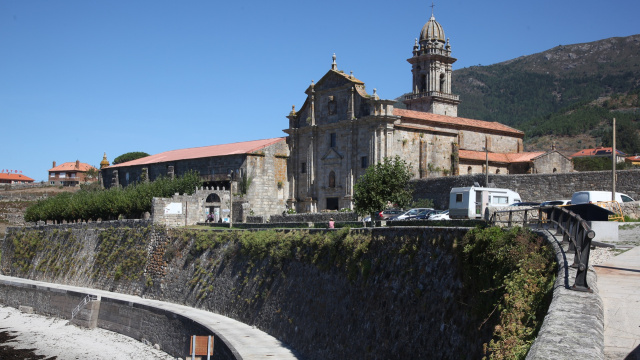Arrabal Neighborhood

MONASTERY OF SANTA MARÍA DE OIA
This former Cistercian monastery by the sea, declared a Historic-Artistic Monument, stands out for its Baroque façade and its defensive history against marit...
Located in a privileged setting on this rugged coast and declared a Historic-Artistic Monument in 1931, the Monastery of Santa María de Oia is the only monastery of the Cistercian order situated on the seafront. This architectural ensemble is the result of the merging, in 1137, of three small monasteries in the region governed by the Benedictine rule and under the protection of Alfonso VII. Its consecration to the Cistercian order in 1185 did not only influence the monastery’s building works, but gave it personality and artistic character.
The church, built between the 12th and 13Ith centuries, dominates the landscape with its powerful Baroque façade, highlighted by its statue of the Virgin of the Sea, although in its interior it maintains the characteristics of Cistercian Gothic.
In the sixteenth century, the church’s choir loft was built and the royal cloister was modified by adding a floor. In the seventeenth century, several building works were carried out to fortify the monastery—building the surrounding walls, the beach wall, as well as the enclosure that surrounds the forest and the weapons’ square. In the 18th century, the bell-tower, the current façade and the naves that make up the space currently known as the patio of the orange trees were built.
The monastery was an important defensive bulwark against constant maritime invasions. Throughout the sixteenth century, Oia was equipped with artillery and other weapons to prevent pirates from disembarking. Thereby, in 1624, the monks fought against Turkish pirates attacking two ships, one French and the other English. These courageous acts made them worthy of the title of "artillery monks" and subsequently, Felipe IV bestowed the title of Imperial and Royal Monastery.
In 1835, Cistercian life came to an end due to the confiscation of the monastery, which became private property through auction. In 1838 the parish of Santa María was constituted, and the monastic church became the parochial seat. From 1910 to 1931, it was rented to the Portuguese Jesuits and during the civil war it was used as a concentration camp for Republican prisoners.
At present, the monastery is a private property.
The church, built between the 12th and 13Ith centuries, dominates the landscape with its powerful Baroque façade, highlighted by its statue of the Virgin of the Sea, although in its interior it maintains the characteristics of Cistercian Gothic.
In the sixteenth century, the church’s choir loft was built and the royal cloister was modified by adding a floor. In the seventeenth century, several building works were carried out to fortify the monastery—building the surrounding walls, the beach wall, as well as the enclosure that surrounds the forest and the weapons’ square. In the 18th century, the bell-tower, the current façade and the naves that make up the space currently known as the patio of the orange trees were built.
The monastery was an important defensive bulwark against constant maritime invasions. Throughout the sixteenth century, Oia was equipped with artillery and other weapons to prevent pirates from disembarking. Thereby, in 1624, the monks fought against Turkish pirates attacking two ships, one French and the other English. These courageous acts made them worthy of the title of "artillery monks" and subsequently, Felipe IV bestowed the title of Imperial and Royal Monastery.
In 1835, Cistercian life came to an end due to the confiscation of the monastery, which became private property through auction. In 1838 the parish of Santa María was constituted, and the monastic church became the parochial seat. From 1910 to 1931, it was rented to the Portuguese Jesuits and during the civil war it was used as a concentration camp for Republican prisoners.
At present, the monastery is a private property.

MONASTERY OF SANTA MARÍA DE OIA
This former Cistercian monastery by the sea, declared a Historic-Artistic Monument, stands out for its Baroque façade and its defensive history against marit...

A CAMBOA
Discover an ancient stone fishing structure from the 16th century, visible only at low tide. A historical testimony to monastic ingenuity.

Cross of Esmoleiro
Visit an ancient transept from 1764, with a unique inscription and a representation of the three Souls. Admire its Ionic design and simple quadrangular cross.

CASA HENRIQUETA
This emblematic 18th century building, with its exterior staircase and granite stone walls, offers a unique glimpse into the region's architectural past.

SAN COSME FOUNTAIN
This port retains a historic spring still in use, famous for its supposed healing properties and annual religious celebrations.

RECTORAL HOUSE
A historic building from the 18th century, church property, with unique architectural elements and recent modifications.

PUERTAS HOUSE
This place offers a unique architecture with granite stone walls and a cross on its façade, alluding to an ancient hermitage.

A PICOTA
A historic place where justice was meted out in the Middle Ages and where seaweed gathering was convened, it retains its medieval charm.

PRISION FOR WOMEN AND MEN
Discover ancient monastic buildings with gabled roofs and granite walls, witnesses to a fascinating history.

CROSS OF PORTIÑO
This ancient cross of the "De Cruz" type is notable for its unique design with a quadrangular platform, octagonal pedestal and rhomboidal cross decorated wit...

SANTA MARÍA DE OIA BEACH
This small beach next to a Cistercian monastery is ideal for experienced surfers, but only accessible at low tide.

A Camboa
Specialising in grilled meats and cod, Portuguese-style cod.

Bar O Porto

Casa Henriqueta
Traditional Galician cuisine restaurant, personalised service for all our customers. At the foot of the Monastery of Oia with views from our terrace.

Casa Puertas
Restored 17th century rural accommodation, located in a harbour, 50 metres from the beach and a monastery, with services and amenities.

Café Bar Puertas
Café bar, beer and wine bar. They also offer snacks.

Bar Terraza do Mosteiro
Montes de Oia Community Bar, located in the Casa Cultural de Sta. María de Oia